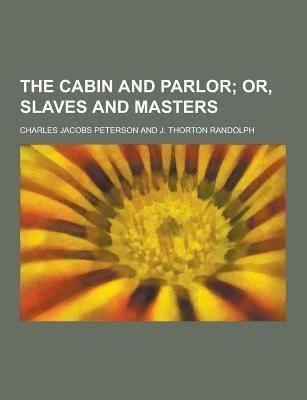Language English Publication date 1852 Country United States of America | Publisher T. B. Peterson Ltd. Originally published 1852 Genre Anti-Tom literature | |
 | ||
Pages c.300 pp (May change depending on the publisher and the size of the text) Similar The Ebony Idol, Uncle Robin - in His Cabin, The Planter's Northern, Aunt Phillis's Cabin, Little Eva: The Flower of the So | ||
The Cabin and Parlor; or, Slaves and Masters is an 1852 novel written by Charles Jacobs Peterson under the pseudonym of J. Thornton Randolph.
Contents
Overview
The Cabin and Parlor is an example of the pro-slavery plantation literature genre that emerged from the Southern United States in response to the abolitionist novel Uncle Tom's Cabin by Harriet Beecher Stowe, which had been published in book form in that year, and had been criticised in the Southern United States for exaggerating the workings of slaveholding.
Whereas the majority of anti-Tom novels focussed on the evils of abolitionism, Peterson instead attacks the capitalist attitudes of the north, as well as their use of "white slaves" (the working classes) over black slaves. This attitude would appear again in Caroline Rush's The North and the South; or, Slavery and Its Contrasts, also published in 1852.
Plot summary
The story begins with the sudden death of a wealthy Virginia landowner, Mr. Courtenay, a kindly plantation owner who has died before being given the opportunity to pay off his debts, leaving his family in debt and facing destitution.
In an effort to pay off the debts, the family sell their slaves, among whom is the kindly Uncle Peter, who takes a liking to Courtenay's daughter, Isabel, and vows to help her in any way possible in thanks for the kindness shown to him by the Courtenays. The money earned is nominal, leaving it to Isabel and her brother Horace to acquire jobs in order to pay the remaining bills and to support their ailing mother.
Isabel finds a job as a schoolteacher, whilst Horace heads to an unidentified city in the north (inferred to be Philadelphia), where he becomes a "Northern slave" (i.e. a clerk) to the malevolent Mr. Sharpe, a ruthless capitalist who works Horace like as though he were a white slave.
As the Courtenays continue to struggle, Isabel eventually finds comfort in a young slaveowner named Walworth, the son of an old Virginia family, who travels back and forth between north and south. When Horace dies of exhaustion in the north, Walworth comforts him in his final hours, and delivers his final requests to his sister in the south.
Whilst travelling together, Walworth and Isabel are caught in the midst of an anti-Black riot, from which Walworth is able to save Isabel from harm. Isabel, eternally grateful, begins to have romantic feelings for Walworth, and they eventually marry. The marriage, by a twist of fate, allows Isabel to reclaim her wealth and property - including her slaves - and is finally reinstated at Courtenay Hall.
Characters
Publication history
Peterson's novel was among the earliest examples of the plantation literature genre, having first appeared six months after Uncle Tom's Cabin appeared in book form.
The publishers of Peterson's novel - T.B. Peterson Ltd. (Theophilus B. Peterson was Charles' brother) - would later go on to publish other anti-Tom novels, most notably the 1854 novel The Planter's Northern Bride by Caroline Lee Hentz.
